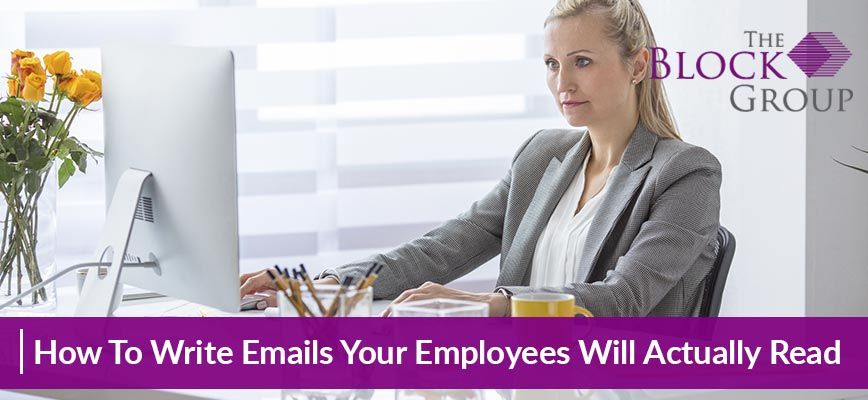
275 - How To Write Emails Your Employees Will Actually Read
While email remains an essential tool for business communication, email overload and employee engagement present real challenges.
With more than 200 billion emails sent and received every day, it is no surprise many go unopened or unread. Whether you are responsible for sending executive communications, HR and benefits information or engaging employees with company news, being an effective communicator means knowing how to carefully craft a corporate email. The objective is not only to reach the intended audience but to be read and understood.
Email isn’t going anywhere, so we might as well get smarter about it. Following these best practices will help you increase your employee email engagement.

Send from a recognized leader, not a general mailbox.
If you consistently broadcast a wide variety of email from a single shared mailbox, you are likely conditioning your employees to ignore most of those messages. Office workers spend an average of 2.5 hours daily reading and replying to email, so they use shortcuts to filter through nearly 200 inbox items to focus on what seems important.
The primary filter used is who the message is from. Think of a from address as a channel people tune into. Newsletters should be sent from the newsletter name. Benefits email should come from a specific benefits mailbox or the person in charge of that program. Executive, management and leadership messages, even if not written by them, receive more attention and readership when addressed from their name. If you want your employees to read the email, send it from the boss.

Make it mobile responsive.
While internal email open rates are 77% on average, today nearly 50% of those opens are coming from mobile devices. As Microsoft Office is the defacto corporate standard for corporate email, creating mobile responsive Outlook pages makes email more likely to be read, instead of fonts shrinking down to unreadable size on the mobile device. As most corporate email contains links to internal content resources, it’s critical for IT teams to implement mobility software and secure intranets to increase accessibility and productivity.

Write shorter, more descriptive subject lines.
The subject line is secondary filter people use to funnel their limited email attention. According to our company's analysis, the most effective subject lines are under five words or between nine and 11 words. A good subject line provides just enough information for the reader to become curious, and it should never be tricky or misleading. A good curiosity strategy is to turn subject lines into questions. Ask “Why would I read this?" and then provide the answer in the message content. Consider using prefixes beyond the standard “RE” and “FW.” Subject line prefixes such as “FYI”, “FAQ,” “ACT” or “REQ” will help set expectations and enable faster prioritization.

Write shorter messages; keep email content to 500 words or less.
Attention spans are short, and your inbox is a work processing tool, so get right to the point when composing email content. Make messages as concise and clear as possible and avoid these passive aggressive phrases. Follow the newspaper inverted pyramid format by leading with a summary of the most important information. Total message content of 500 words or less, which takes under two minutes to read, is the sweet spot for the highest readership rates. The longer the email, the less likely it is to be read.
Using big company logos and banners for internal communications are mostly a waste of the prime real estate at the top of the email message. Standardized formats with well-recognized company branding are important but can be accomplished via fonts, colors, layout and image styles and footers, allowing you to put key messages and actions items right up at the top.

If you really want readers to do something, send one link.
Email is widely used for calls to action and sending links to more information, and the highest click-through rates come from shorter email messages containing just one link or action item.
When you really want people to do something, whether to sign up for training, read a new policy or enroll in benefits, it’s best to follow another old newspaper adage and don’t bury the lede. Include a single link in the email content and put it right up near the top of the email, preferably set in a different color or a button block. Generally, the more links you include in the content, the lower the click-through rate.

Use more — and more authentic — images.
Plain text email works and is even preferable for most day-to-day communication. For corporate communications, you can improve readership by using more images. The highest readership rates come from pages that are more than 50% images. The best images enhance the story, evoke a mood or make an emotional connection. Candid images of your employees in action will add life and depth to your communications.

Arrive at the top of the inbox.
With so many email messages competing for attention, how do you keep your critical corporate communications from getting buried? One good strategy: sending messages earlier in the day and earlier in the week tends produces higher engagement.
Ideally, you want to arrive near the top of the inbox when the employee starts their work day. Instead of sending a global message on your time zone, it’s better to schedule the distribution to arrive at 9 a.m. in the employee’s time zone.
A good strategy for recurring email programs such as newsletters and leadership communication is to schedule that messaging into the employee’s routine workday. If the "Monday Morning Missive" arrives every Monday at 9 a.m., employees will come to anticipate it and arrange their work schedule to engage with it.
While email remains the most popular and essential enterprise communications channel, there’s still much to learn about making email more effective. Stay tuned to this column for more best practices to follow.
Source: Forbes




